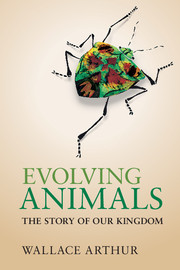Book contents
- Frontmatter
- Dedication
- Contents
- Preface
- Acknowledgements
- 1 What is an animal?
- 2 Before there were animals
- 3 How to make a fossil
- 4 The Cambrian explosion
- 5 How to make a species
- 6 Jellyfish and their kin
- 7 How to make a tree
- 8 The enigmatic urbilaterian
- 9 Animal symmetry and heads
- 10 A plethora of worms
- 11 Trends in animal complexity
- 12 Where the octopus is king
- 13 How to make an animal
- 14 Exoskeletons galore
- 15 Extinction
- 16 Mouth first, mouth second
- 17 Comparing embryos
- 18 Larvae, mouthparts and moulting
- 19 The animal toolkit
- 20 Vertebrate origins and evolution
- 21 From water to land to water
- 22 Variation and inheritance
- 23 Evolutionary novelties
- 24 Human origins and evolution
- 25 Animal plasticity
- 26 The nature of adaptation
- 27 The direction of evolution
- 28 Animal extremophiles
- 29 Extraterrestrial animals?
- 30 The ghost in the machine
- Appendix
- References
- Index
8 - The enigmatic urbilaterian
Published online by Cambridge University Press: 05 August 2014
- Frontmatter
- Dedication
- Contents
- Preface
- Acknowledgements
- 1 What is an animal?
- 2 Before there were animals
- 3 How to make a fossil
- 4 The Cambrian explosion
- 5 How to make a species
- 6 Jellyfish and their kin
- 7 How to make a tree
- 8 The enigmatic urbilaterian
- 9 Animal symmetry and heads
- 10 A plethora of worms
- 11 Trends in animal complexity
- 12 Where the octopus is king
- 13 How to make an animal
- 14 Exoskeletons galore
- 15 Extinction
- 16 Mouth first, mouth second
- 17 Comparing embryos
- 18 Larvae, mouthparts and moulting
- 19 The animal toolkit
- 20 Vertebrate origins and evolution
- 21 From water to land to water
- 22 Variation and inheritance
- 23 Evolutionary novelties
- 24 Human origins and evolution
- 25 Animal plasticity
- 26 The nature of adaptation
- 27 The direction of evolution
- 28 Animal extremophiles
- 29 Extraterrestrial animals?
- 30 The ghost in the machine
- Appendix
- References
- Index
Summary
Evolutionary trees, such as those we looked at in the last chapter, are very abstract things. They take a complex process involving many animals, molecules, morphological characters, matings, migrations, speciation events and geography, and render this multi-level, four-dimensional complexity into a simple-looking picture on a single sheet of paper. For some purposes that’s great. After all, when we are trying to understand a complex process, any device that captures the essence of the process in a simple diagrammatic way is incredibly helpful. But it can also be misleading; and whether it does indeed capture ‘the essence of the process’ can be questioned. I think this is especially true in relation to the extinct animal that has come to be called the urbilaterian (and nicknamed, somewhat tongue-in-cheek, ‘Urbi’).
What was this strangely named beast? Answers to this question can come in a variety of forms. In terms of the name, it uses the German prefix ur-, meaning first or original, and couples that with bilaterian, which is short for ‘bilaterally symmetrical animal’. As we saw in previous chapters, the most basally branching animals either had little or no symmetry (sponges) or had radial symmetry (jellyfish and their kin). But most other animals that we see around us are bilaterally symmetrical, albeit with various degrees of imperfection. Therefore, at some point in the distant past, bilateral symmetry must have originated, and the first animal displaying it was the urbilaterian.
Information
- Type
- Chapter
- Information
- Evolving AnimalsThe Story of our Kingdom, pp. 77 - 84Publisher: Cambridge University PressPrint publication year: 2014
